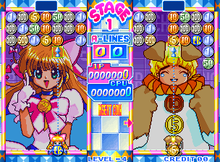
The Neo Geo, stylized as NEO•GEO and also written as NEOGEO, is a ROM cartridge-based arcade system board and fourth-generation home video game console released on April 26, 1990, by Japanese game company SNK Corporation. It was the first system in SNK's Neo Geo family.

SNK Corporation is a Japanese video game hardware and software company. It is the successor to the company Shin Nihon Kikaku and presently owns the SNK video game brand and the Neo Geo video game platform, and electronics. SNK's predecessor Shin Nihon Kikaku Corporation was founded in 1978 by Eikichi Kawasaki. In 1981, the name was informally shortened to SNK Corporation, which became the company's official name in 1986.

Metal Slug is a 1996 run and gun arcade video game originally developed by Nazca Corporation and released by SNK for the Neo Geo MVS. It is the first installment in the eponymous series. Set in 2028, players assume the role of Peregrine Falcon Strike Force soldiers Marco Rossi and Tarma Roving on a fight against the Rebel Army led by Donald Morden and overthrow his coup d'état to prevent a New World Order.

Blazing Star is a shoot 'em up video game developed by Yumekobo and published by SNK in 1998 for the Neo Geo arcade and home systems. It is a follow-up to Pulstar (1995) and features side-scrolling action similar to its predecessor and different ships with varying characteristics. It was made less challenging than its predecessor, and the graphic quality was improved upon.

Twinkle Star Sprites is a competitive vertically scrolling shooter arcade video game created by ADK and published by SNK in 1996. It was ADK's last production for the Neo Geo. Two players are each in separate, side-by-side, vertically scrolling levels. Combinations of shots and timed power-ups damage the other player. These attacks also serve as counters to the opponent's attack.

Garou: Mark of the Wolves is a 1999 fighting game produced by SNK, originally for the Neo Geo system and then as Fatal Fury: Mark of the Wolves for the Dreamcast. It is the eighth installment of the Fatal Fury series.

Aero Fighters 2 is a vertical-scrolling shoot 'em up arcade game released in 1994 by Video System. It is developed by SNK and released in Japan, North America and Europe. It is the second part of the Aero Fighters series followed by the third part Aero Fighters 3 and a spin-off Aero Fighters Assault. It was initially released as a cabinet token base game.
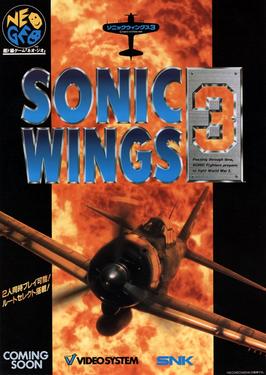
Aero Fighters 3, known as Sonic Wings 3 in Japan and Europe, is a vertical-scrolling shoot 'em up arcade game released in 1995 by Video System. The Neo Geo AES version was not released in North America, but the Neo Geo MVS and Neo Geo CD versions were released in North America. The game was later released for Nintendo Switch in 2018 by the eventual copyright holder for the game, Hamster Corporation.

Last Resort is a horizontally scrolling shooter by SNK released as an arcade video game in 1992. It was also released for the Neo-Geo and Neo Geo CD systems, SNK Arcade Classics Vol. 1 for the PlayStation 2, PlayStation Portable, and Wii, as well as ACA Neo-Geo for the PlayStation 4 and Xbox One.

Burning Fight is a beat 'em up arcade game released by SNK in 1991 for the Neo Geo MVS system. Introduced to capture a share in the then-popular beat 'em ups market, it was meant to compete with Technōs' Double Dragon, the leader of the genre at the time. Three years after its release in the arcades and on the Neo Geo AES, it was released on Neo Geo CD as the only other home version.

Ghost Pilots is a vertically scrolling shooter arcade video game released in 1991 by SNK. It has elements similar to Capcom's 194X series, but the player controls a seaplane.

Zed Blade is a horizontally scrolling shooter arcade video game developed by NMK and originally published by SNK on September 13, 1994. It is the only game created by NMK for the Neo Geo arcade platform. In a science fiction setting, players choose one of three characters to attempt to overthrow an army of enemies led by the on-board supercomputer at the automated Yggdrasil space station and seize full control of it once again.

Puzzled is a falling-block puzzle video game developed and published by SNK that was released for Neo Geo arcade hardware in 1990, the Neo Geo home console in 1991, and the Neo Geo CD in 1994. The game was ported to mobile phones in 2005, then was re-published by D4 Enterprise on the Wii Virtual Console in June 2011, and it is also one of the twenty games that came pre-loaded on the Neo Geo X console released in 2012. It was also ported in August 2017 to Nintendo Switch, Xbox One, and PlayStation 4 as part of Hamster Corporation's ACA Neo Geo series.

Gururin is a puzzle arcade video game developed by Face, with the assistance of Minato Giken, and originally published by SNK on May 25, 1994. It was the first game to be created by Face for the Neo Geo platform and it was not released on the Neo Geo AES (home).
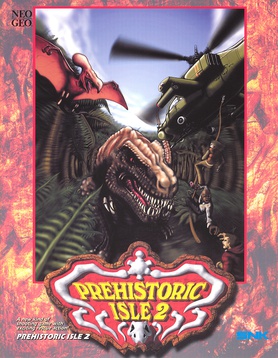
Prehistoric Isle 2 is a 1999 scrolling shooter arcade video game co-developed by Saurus and Yumekobo and published by SNK. It is the sequel to the original Prehistoric Isle, which was developed and released earlier in 1989 by SNK. In the game, players take control of helicopters to shoot at dinosaurs while rescuing people. Although first launched in arcades, the title has since been re-released through download services for various consoles. It received mixed reception since its initial arcade release and garnered less success than its predecessor.

Super Sidekicks is a 1992 soccer arcade video game developed and published by SNK. It is the first installment in the eponymous series and the second soccer game released for Neo Geo MVS, succeeding Soccer Brawl (1991). Featuring an arcade-style approach to soccer compared to other games released at the time, the title allows players to choose any of the available game modes with AI-controlled opponents or other human players with the team of their choosing. Its gameplay uses a simplified two-button configuration.

Super Sidekicks 2: The World Championship is a 1994 soccer arcade video game developed and published by SNK. It is the second installment in the Super Sidekicks series and the third soccer game released for Neo Geo MVS, preceding the original Super Sidekicks (1992). Featuring an arcade-style approach to soccer as its predecessor, the game allows players to choose any of the available game modes with AI-controlled opponents or other human players with the team of their choosing. Its gameplay uses a simplified three-button configuration.
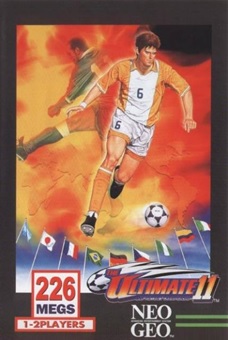
The Ultimate 11: SNK Football Championship is a 1996 soccer arcade video game developed and published by SNK. Despite the international name, it is the fourth installment in the Super Sidekicks series, preceding Super Sidekicks 3: The Next Glory (1995). Featuring an arcade-style approach to soccer much like its predecessors, the game allows players to choose any available game mode to compete with AI-controlled rivals or human players with their preferred team. Although first launched for Neo Geo MVS, the game was ported to Neo Geo AES, in addition of being re-released on download services for various consoles. The title received positive reception from critics but proved to be less popular than its previous iterations. It was followed by Neo Geo Cup '98: The Road to the Victory (1998), which is a remake of Super Sidekicks 3 and served as the final entry in the Super Sidekicks saga.
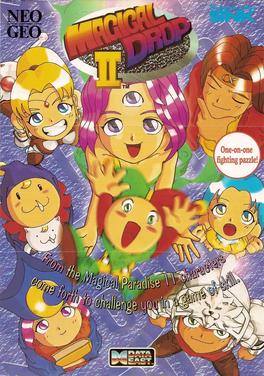
Magical Drop II is a 1996 puzzle video game developed and published by Data East for the Neo Geo arcade and home platforms. It was later ported to Neo Geo CD, Super Famicom, and Sega Saturn. It is the second entry in the Magical Drop series. In the game, the player takes control of one of several characters, battling against computer-controlled opponents before facing the villainous Empress in a final encounter. Gameplay is similar to its predecessor Magical Drop (1995) albeit with improvements; the objective is to clear the screen of constantly advancing colored 'drops' via a character placed at the bottom of the playfield, which can grab drops and make them disappear by putting them as a column of three or more drops of the same color. Two players can also participate in a competitive versus mode.

Magical Drop III is a 1997 puzzle video game developed and published by Data East for the Neo Geo arcade and home platforms. It was later ported to Sega Saturn, PlayStation, Neo Geo Pocket Color, Game Boy Color, Windows, and Zeebo. It is the third entry in the Magical Drop series. In the game, the player takes control of one of several characters, battling against computer-controlled opponents. Gameplay is similar to previous entries albeit with further additions; the objective is to clear the screen of constantly advancing colored 'drops' via a character placed at the bottom of the playfield, which can grab drops and make them disappear by putting drops as a column of three or more of the same color. The player can also participate in a board-style adventure mode, while two players can play against each other in a competitive versus mode.

